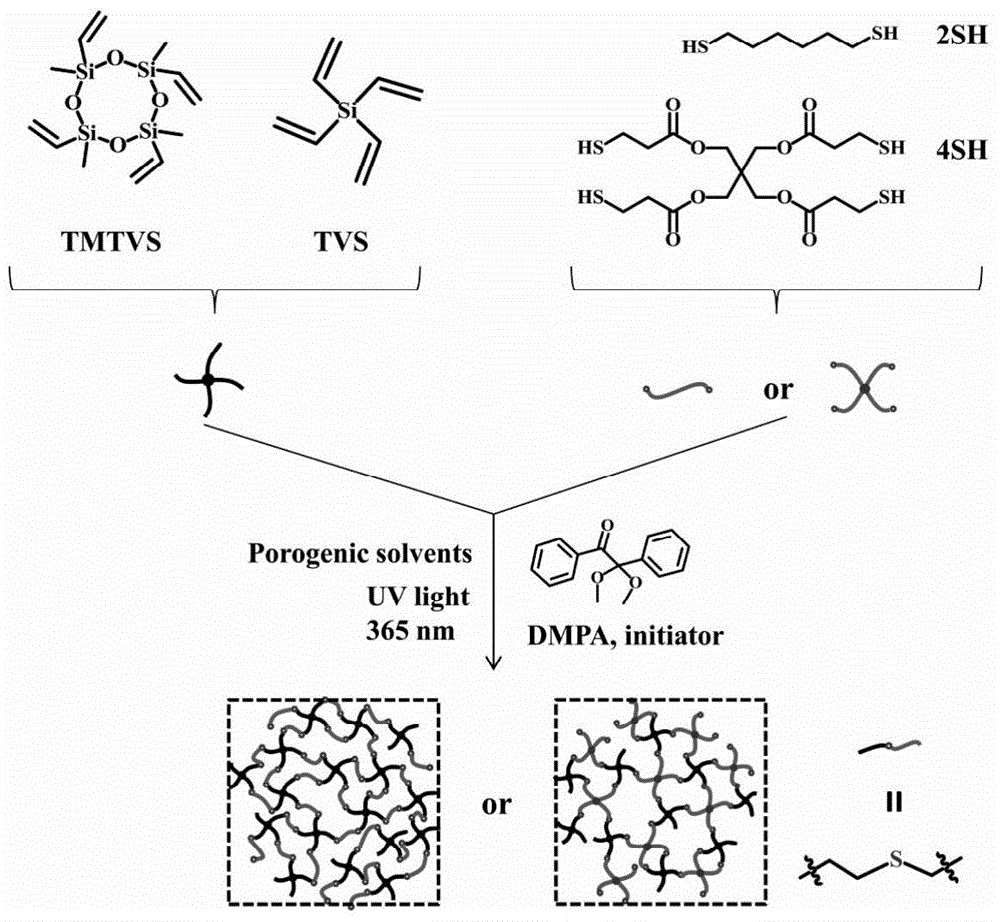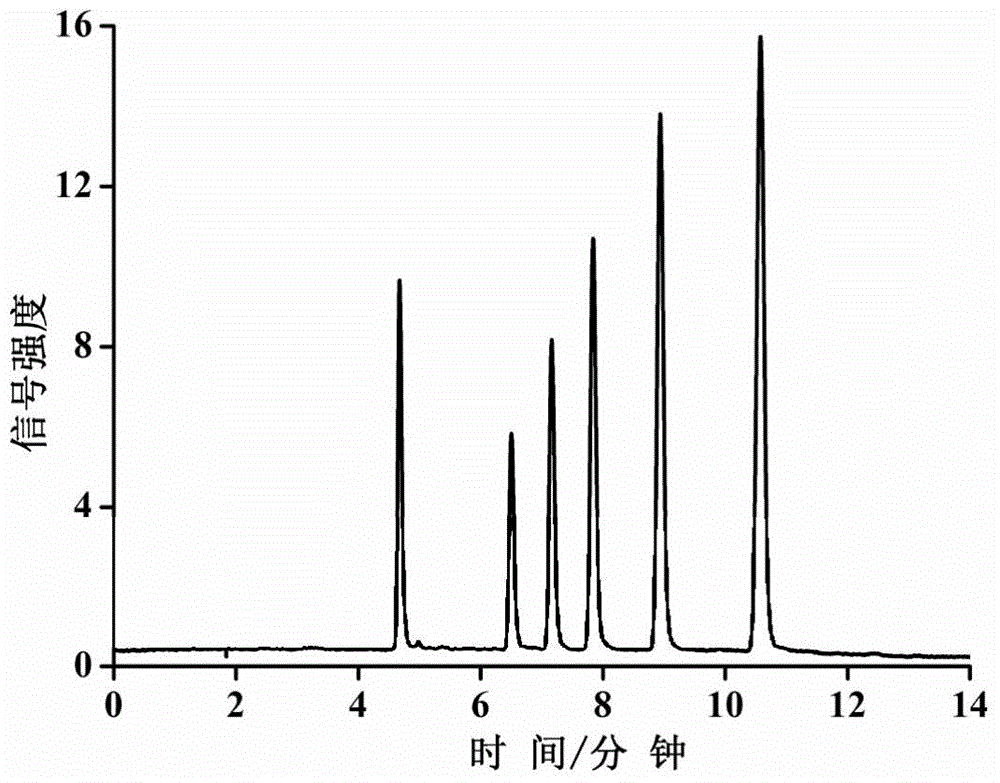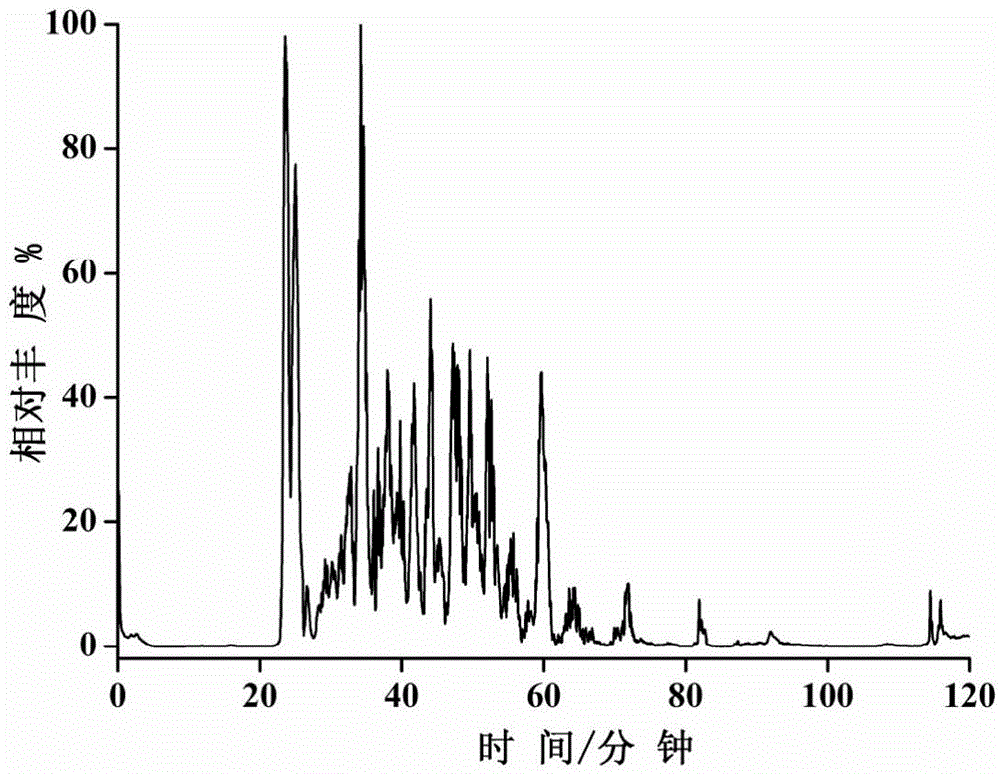Preparation method of organic-inorganic hybrid porous integral material
A monolithic material and hybridization technology, which is applied in the field of preparation of organic-inorganic hybrid porous monolithic materials, can solve problems such as not showing the potential of high-efficiency separation and analysis
- Summary
- Abstract
- Description
- Claims
- Application Information
AI Technical Summary
Problems solved by technology
Method used
Image
Examples
Embodiment 1
[0027] 1. Add 25.0mg of TMTVS reagent to the UV transparent glass bottle.
[0028] 2. Add 21.3 mg of 2SH to the above-mentioned UV transparent glass bottle.
[0029] 3. Add 80 μL of diethylene glycol diethyl ether and 100 μL of n-propanol into the above-mentioned ultraviolet transparent glass bottle.
[0030] 4. Add 0.1 mg of photoinitiator DMPA to the above-mentioned ultraviolet transparent glass bottle, and ultrasonicate the above-mentioned ultraviolet transparent glass bottle for 1 min to mix the components therein evenly, and remove the dissolved oxygen dissolved therein.
[0031]5. Use a syringe to introduce the mixed solution obtained in step 4 into a 75 μm (inner diameter) UV transparent capillary tube that has been pre-activated with vinyltrimethoxysilane, then seal both ends of the capillary tube with silica gel, and then put the remaining mixing liquid in a UV transparent glass bottle with airtight seal.
[0032] 6. Place the UV transparent capillary and UV transpa...
Embodiment 2
[0035] 1. Add 15.5 mg of TVS reagent to the UV transparent glass bottle.
[0036] 2. Add 26.8 mg of 2SH to the above-mentioned UV transparent glass bottle.
[0037] 3. Add 170 μL of diethylene glycol diethyl ether and 10 μL of n-propanol into the above-mentioned ultraviolet transparent glass bottle.
[0038] 4. Add 0.1 mg of photoinitiator DMPA to the above-mentioned ultraviolet transparent glass bottle, and ultrasonicate the above-mentioned ultraviolet transparent glass bottle for 1 min to mix the components therein evenly, and remove the dissolved oxygen dissolved therein.
[0039] 5. Use a syringe to introduce the mixed solution obtained in step 4 into a 75 μm (inner diameter) UV transparent capillary tube that has been pre-activated with vinyltrimethoxysilane, then seal both ends of the capillary tube with silica gel, and then put the remaining mixing liquid in a UV transparent glass bottle with airtight seal.
[0040] 6. Place the UV transparent capillary and UV transpa...
Embodiment 3
[0043] 1. Add 32.4mg of TMTVS reagent to the UV transparent glass bottle.
[0044] 2. Add 35.0 mg of 4SH to the above-mentioned UV transparent glass bottle.
[0045] 3. Add 100 μL of diethylene glycol diethyl ether and 140 μL of n-propanol into the above-mentioned ultraviolet transparent glass bottle.
[0046] 4. Add 0.1 mg of photoinitiator DMPA to the above-mentioned ultraviolet transparent glass bottle, and ultrasonicate the above-mentioned ultraviolet transparent glass bottle for 1 min to mix the components therein evenly, and remove the dissolved oxygen dissolved therein.
[0047] 5. Use a syringe to introduce the mixed solution obtained in step 4 into a 75 μm (inner diameter) UV transparent capillary tube that has been pre-activated with vinyltrimethoxysilane, then seal both ends of the capillary tube with silica gel, and then put the remaining mixing liquid in a UV transparent glass bottle with airtight seal.
[0048] 6. Place the UV transparent capillary and UV trans...
PUM
 Login to View More
Login to View More Abstract
Description
Claims
Application Information
 Login to View More
Login to View More - R&D
- Intellectual Property
- Life Sciences
- Materials
- Tech Scout
- Unparalleled Data Quality
- Higher Quality Content
- 60% Fewer Hallucinations
Browse by: Latest US Patents, China's latest patents, Technical Efficacy Thesaurus, Application Domain, Technology Topic, Popular Technical Reports.
© 2025 PatSnap. All rights reserved.Legal|Privacy policy|Modern Slavery Act Transparency Statement|Sitemap|About US| Contact US: help@patsnap.com



